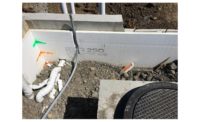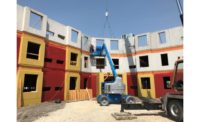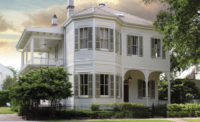Savvy builders know when formulating the true value of a building product, one must consider a combination of the purchase price, the installation cost and the possible long-term operational savings that the product provides to the owner during its lifecycle. At Enterprise Precast Concrete of Texas, Operations Manager, Scott Davis is certain that a high-performance building envelope is one of the wisest investments that can be made on any commercial construction project regardless of client or purpose.
“I’m confident that there is no better value for a wall system than an insulated architectural precast panel,” says Davis, who has been in the construction industry for more than 18 years and now is the operations manager at Enterprise’s Corsicana, Texas office. Enterprise’s headquarters office is located in Omaha, Nebraska, giving the company an effective delivery area that stretches from Galveston, Texas to Minneapolis in a five-hundred-mile radius around each production facility. Davis’ confidence in insulated precast panels is shared by General Manager, John Arehart, who has been with Enterprise since 1988 and has seen the significant evolution of architectural precast panels over a 29-year career.
“High quality concrete additives have really improved the performance and possibilities of architectural precast,” says Arehart, who recalls that in 1988 large panels were 10 feet by 10 feet while today, panels can easily span 12 feet by 50 feet and 15 feet by 35 feet. Arehart has seen the increased size of precast panels compel a cultural shift across the construction industry affecting virtually everything from site logistics and craning operations, to trucking access, delivery sequencing, the equipment required to move massive panels and the skilled labor that secures them in place.
Applications in the Industry
“Insulated precast panels didn’t exist when I started in the business and today they account for more than half of all of our production,” continues Arehart, agreeing with Davis’ assessment of architectural precast’s value in commercial construction. Between an exceptional range of finishes, materials, colors and textures, the possible combinations are limitless for designers. Among countless architecturally significant projects, Enterprise has been a part of the Kauffman Center for the Performing Arts in Kansas City where a combination of insulated and solid panels, including curved shaped pieces, were transported to the jobsite on specially-made panel racks. While at the Bloch School of Business, in Kansas City, the use of insulated precast panels resulted in substantial cost savings over rainscreen framing systems that designers originally envisioned.
Insulated precast panels are very well-regarded for their environmental benefits, which begin with being fabricated in a controlled production facility with virtually no waste. Enterprise’s insulated panels also provide a complete thermal break between the interior and exterior façade, so they are a great way for architects to meet building codes, while supporting sustainability with a high-performance building envelope that works well in any climate. During construction, large sections of exterior walls and floors are hoisted into place by cranes, allowing the building to be dried-in quickly for year-round progress on interior components.
Enterprise uses a highly-specialized and proprietary wall system called the Altus CarbonCast panel which was developed by a conglomerate of architectural precast producers with exclusive ownership of the technology. Founded in 2003 under a “co-opetition” model, AltusGroup companies like Enterprise engineer, manufacture, validate and market precast innovations and then compete against one another for contracts when their service areas overlap.
Using carbon fiber technology, the award-winning Altus CarbonCast panel sandwiches the insulation between the architectural exterior wythe and a smooth grey concrete interior wythe to become the only type of architectural precast panel to provide 100 percent composite action for exceptional structural capacity. With all of the forming, mixing, pouring and curing technology in-house, Enterprise relies on Foam-Control Expanded Polystyrene rigid foam insulation as the most effective core for their CarbonCast panels and generally achieves an R-value of between 4 and 5 for every inch of EPS foam thickness.
The Supplier’s Help
“ACH Foam Technologies is an EPS insulation manufacturer we have come to count on for a few reasons,” says Arehart. “Frequently our projects involve panels of many different sizes and material compositions. They are able to manufacture rigid foam insulation in a tremendous array of lengths, thicknesses, densities and compressive strengths, which allows us to fabricate any panel on any project with ease and little waste.”
ACH Foam Technologies is currently supplying Enterprise with a steady stream of their Foam-Control 130 product for CarbonCast panels going into a new $1 billion data center for a well-known technology company building out more than 250,000 square feet of new space in Fort Worth, Texas. With operations and production responsibilities, both Arehart and Davis appreciate the company’s willingness to organize and develop detailed product numbering systems for each order to Enterprise’s specifications. This organization allows fabricators to quickly pull the required insulation pieces and build each panel’s insulated interior in a repeatable process.
The manufacturer understands that construction is a fluid, dynamic process and being flexible to their customers’ schedules is a brand strong suit. Sales representatives work closely with buyers to build an initial product delivery schedule and then continually monitor the push and pull of each project in weekly check-ins to make required adjustments. Enterprise also finds that EPS products are easier to use than comparable XPS materials and Arehart notes that the slightly textured face of rigid EPS foam provides a gripable surface for the concrete to bond, creating a stronger seal between layers.
In addition to Foam-Control 130 insulation used in Enterprise’s precast panels, ACH Foam Technologies also makes Foam-Control Plus+ architectural insulation which delivers high compressive strengths and high R-Values. Foam-Control and Foam-Control Plus+ products solve many other construction challenges from roof insulation to vertical wall applications and underslab insulation, as well as being an exceptionally strong yet lightweight concrete void-filler.
For the Record
Today, Enterprise Precast aims to produce and ship out an estimated 2,500 square feet of new panel in each of their two facilities every day. They are typically supplying between six to 12 pieces on each of five separate projects a day from both Omaha and Corsicana. Orchestrating some 50 different panel trailers and hundreds of different frames and racks to transport the finished panels to jobsites up to five-hundred miles away generally in just-in-time deliveries requires a substantial team effort.
“Getting a steady stream of panels to each of the jobsites as the cranes are ready to pick and set them is an intricate ballet in a lot of ways,” laughs Davis knowingly. “We have capacity to store roughly 1,500 panels at our plant and we maintain constant communication with clients to understand the push and pull of each contract’s schedule so the panels keep pace regardless of weather or other schedule impacts.”
Value analysis of any building system or product requires a holistic view of the project and the objectives the client appreciates the most in their own measure of success. Finding a balance between cost, schedule, quality, and appearance shouldn’t feel like a compromise on any commercial building project regardless of scope or complexity. Thanks in part to the dynamic range of possibilities of today’s insulated architectural precast panels, clients, designers, and builders can realize virtually any design imaginable with a high-performance building envelope that builds quickly and is readily in-line with market costs.









Report Abusive Comment